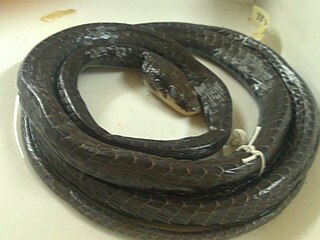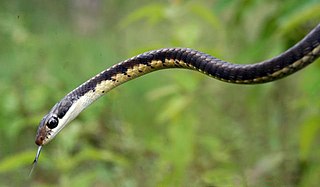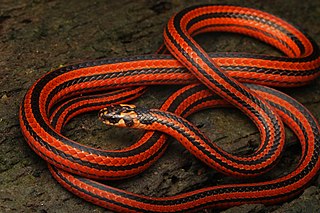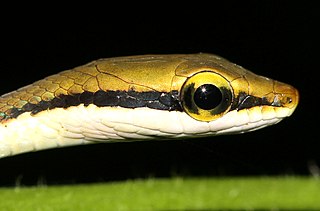
Ahaetulla perroteti, known commonly as the bronze-headed vine snake, Perrotet's vine snake, or the Western Ghats bronzeback, is a species of mildly venomous, rear-fanged snake in the family Colubridae. The species is endemic to the Western Ghats in South India.

Dendrelaphis bifrenalis, also called Boulenger's bronzeback, Boulenger's bronze-back, and Travancore bronze-brown snake, is a colubrid snake native to Eastern Ghats of Southern India and Sri Lanka. It was first described by George Albert Boulenger in 1890. Dendrelaphis wickrorum from Sri Lanka was previously confused with this species.

Dendrelaphis cyanochloris, commonly known as Wall's bronzeback or the blue bronzeback, is a species of colubrid snake found in Southeast Asia.

Dendrelaphis grandoculis, commonly called as the large-eyed bronzeback or southern bronzeback, is a species of Colubrid snake endemic to the Western Ghats of southwestern India.

Dendrelaphis humayuni, also known commonly as the Nicobar bronzeback or Tiwari's bronzeback, is a species of snake in the family Colubridae. The species is endemic to the Nicobar Islands of India.

Dendrelaphis tristis is a species of colubrid tree-snake found in South Asia.

Ptyas mucosa, commonly known as the Oriental rat snake, dhaman or Indian rat snake, is a common non-venomous species of colubrid snake found in parts of South and Southeast Asia. Dhamans are large snakes. Typical mature total length is around 1.5 to 1.95 m though some exceed 2 m. The record length for this species was 3.7 m, second only to their cousin Ptyas carinata among living colubrid snakes. Despite their large size, oriental ratsnakes are usually quite slender with even a specimen of 2 m commonly measuring 4 to 6 cm only around in diameter. Furthermore, the average weight of ratsnakes caught in Java was around 877 to 940 g, though larger males of over 2.3 m may easily weigh over 2.5 kg (5.5 lb). Their color varies from pale browns in dry regions to nearly black in moist forest areas. Rat snakes are diurnal, semi-arboreal, non-venomous, and fast-moving. Rat snakes eat a variety of prey and are frequently found in urban areas where rodents thrive.

The checkered keelback, also known commonly as the Asiatic water snake, is a common species in the subfamily Natricinae of the family Colubridae. The species is endemic to Asia. It is non-venomous.
Psammophis leithii, commonly called the Pakistan sand racer, Pakistani ribbon snake, or Leith's sand snake, is a species of rear-fanged snake in the family Psammophiidae. The species is native to South Asia. It is harmless to humans.

Calliophis nigriscens, commonly known as the black coral snake or striped coral snake, is a species of venomous elapid snake endemic to the Western Ghats, India.

Dendrelaphis caudolineatus, commonly known as the striped bronzeback or grey bronzeback, is a species of colubrid snake found in Southeast Asia.

Dendrelaphis is a genus of colubrid snakes, distributed from Pakistan, India and southern China to Indonesia, Timor-Leste, the Philippines, Australia, New Guinea and the Solomon Islands. There are over forty described species. Asian species are known commonly as bronzebacks, while the Australo-Papuan species are simply called treesnakes. All are non-venomous and entirely harmless to humans.
Polemon neuwiedi, called commonly the Ivory Coast snake-eater or Neuwied's polemon, is a species of mildly venomous rear-fanged snake in the family Atractaspididae. The species is endemic to West Africa.

Dendrelaphis schokari, also known as the common bronze-back or Schokar's bronzeback, is a species of non-venomous arboreal snake in the family Colubridae. The species is endemic to Sri Lanka.

Dendrelaphis girii, Giri's bronzeback tree snake or Giri's bronzeback, is a species of diurnal, arboreal, Colubrid snake endemic to the Western Ghats of southwestern India.

Ahaetulla mycterizans, the Malayan green whipsnake or Malayan vine snake, is a slender arboreal colubrid vine snake found in Southeast Asia.

Dendrelaphis formosus, commonly known as either the elegant bronzeback or beautiful bronzeback tree snake, is a snake species in the family Colubridae from Southeast Asia.

Dendrelaphis haasi, also known commonly as Haas' bronzeback, Haas's bronzeback, Haas's bronzeback snake, and Haas's bronzeback tree snake, is a species of snake in the family Colubridae. The species is native to Southeast Asia.
Dendrelaphis ngansonensis, commonly known as either the Nganson bronzeback or Nganson bronzeback tree snake, is a species of snake in the family Colubridae, sound in Southeast Asia.

Dendrelaphis striatus, commonly known as the banded bronzeback or striated bronzeback treesnake, is a species of snake of the family Colubridae found in Southeast Asia.



















